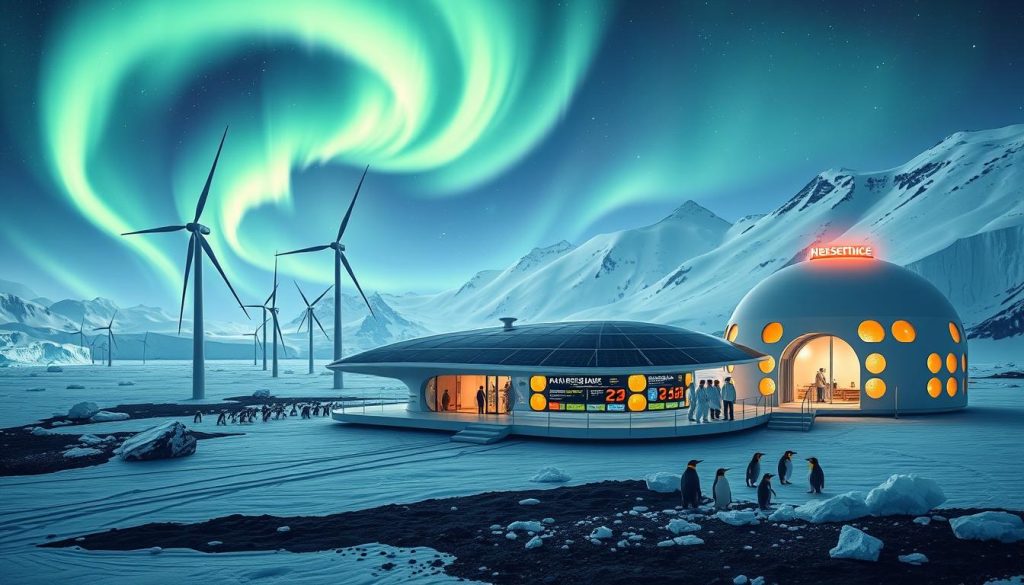Entrepreneurship in Antarctica brings forward unique business models. These models are vital for success in tough conditions. The icy continent’s distinct challenges call for innovative and resilient strategies. Entrepreneurs must adapt to Antarctica’s unique environment to succeed in such a harsh place. This article explores the various opportunities in Antarctica, highlighting their significance.
Introduction to Antarctica’s Unique Business Environment
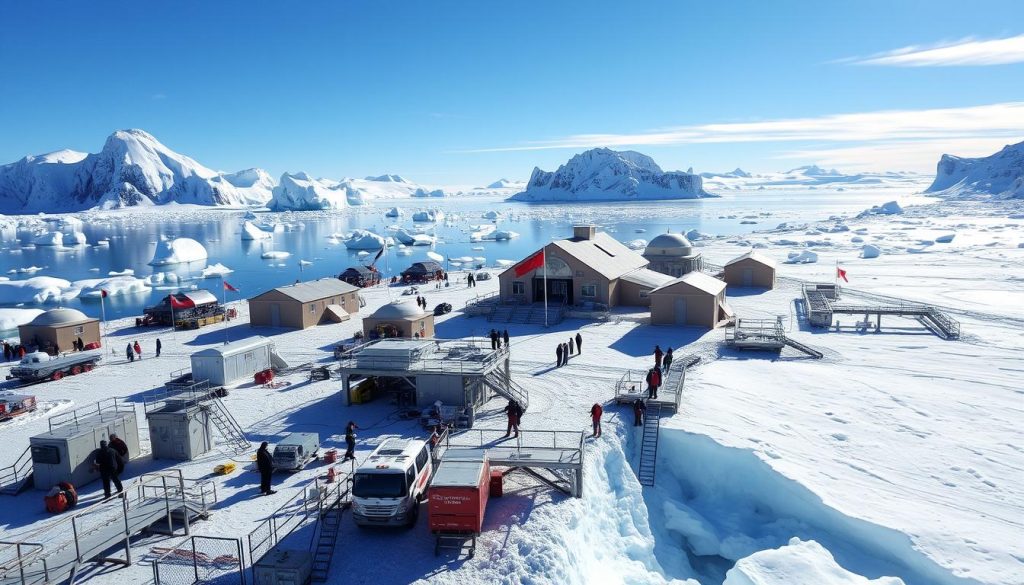
Antarctica offers a unique setting for businesses, filled with challenges not seen elsewhere. Its extreme weather, remote location, and strict rules make it a tough place for starting up. Despite these hurdles, businesses mainly focus on scientific research and tourism. They highlight the importance of teamwork and managing resources well.
The weather affects how businesses run a lot. Entrepreneurs must be ready to change plans when needed to keep going. Also, as the climate changes, new chances for businesses focused on conservation and using resources wisely are emerging.
So, understanding Antarctica’s business world is key for anyone wanting to succeed there. Looking at its past, the problems it faces today, and the future possibilities helps us see what doing business in Antarctica involves. This sets the stage for exploring what lies ahead for businesses in this unique place.
Understanding the Harsh Conditions of Antarctica
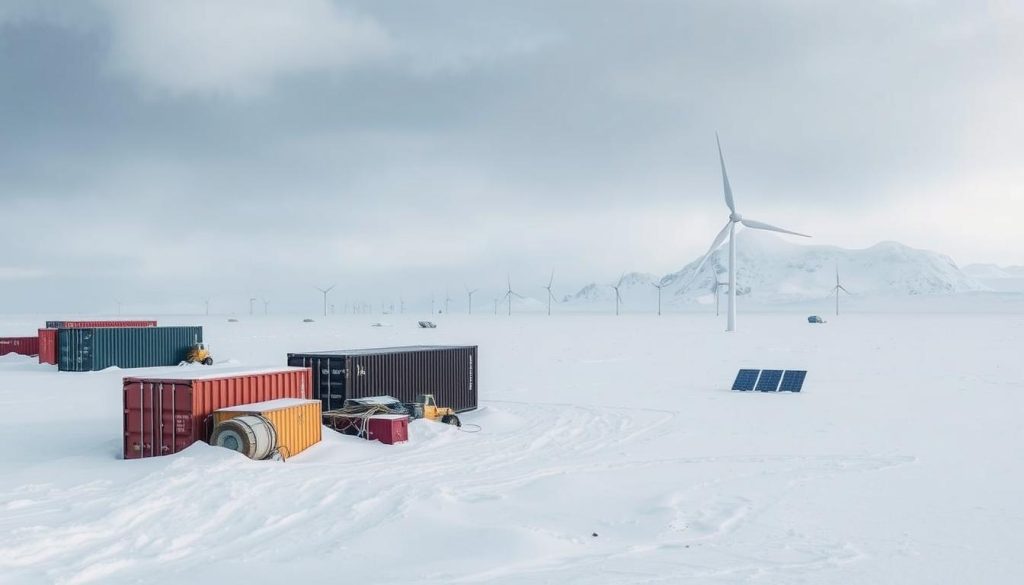
The Antarctic climate presents significant challenges for businesses. They face the intense cold and unpredictable weather. These conditions demand careful planning and adaptability for success.
Climate and Weather Challenges
Antarctica’s severe weather can halt business processes and put people at risk. Factors include:
- Extended periods of darkness
- Unpredictable storms
- Extreme temperature variations
Businesses must build small, but tough, teams. They also need solid plans to tackle these challenges. Adapting is key in handling the Antarctic climate.
Geographical Barriers for Business
The isolation of Antarctica makes transport hard. Essential factors to think about include:
- Lack of commercial airports
- Limited access routes
- Need for strategic partnerships
Setting up necessary infrastructure requires creative solutions. Firms have to overcome these barriers to operate effectively. This involves dealing with the area’s remoteness.
Best Business Models for Antarctica’s Extreme Conditions
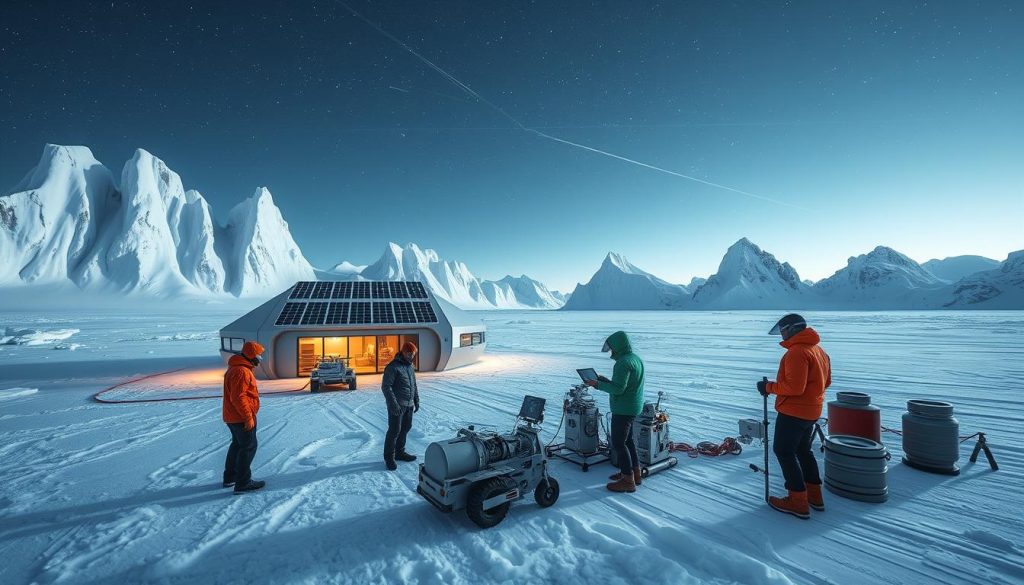
In the harsh realms of Antarctica, businesses must plan strategically and understand extreme weather tactics. They need inventions that can handle the cold, ice, and sudden changes. With such strategies, teams become strong, making sure things work well, even in tough conditions.
Adaptation to Extreme Weather
Companies here use special building methods and materials for the harsh weather. They focus on strong structures and the wellbeing of employees. Training with mental support helps teams deal with the harshness of Antarctica.
Your Business Infrastructure
Strong business foundations are key for efficiency in Antarctica. Buildings that save energy, advanced transport, and logistics solutions are essential. Decisions should be eco-friendly as the region has fragile ecosystems. Smart planning and new methods make a successful setup that cares for nature.
Resource Availability and Sustainability

Antarctica is rich with natural resources like fish and valuable minerals. It’s crucial for responsible businesses to understand these resources and stick to proper management plans. Such sustainable methods ensure minimal harm to the environment. This protects the ecosystem and the resources of this unique continent.
Natural Resources in Antarctica
This continent offers lots of opportunities thanks to its biodiversity and minerals. Companies taking resources must focus on sustainability and follow the rules. This way, they can use the resources wisely without harming nature.
Environmental Regulations and Impact
Companies working in Antarctica must follow the Antarctic Treaty System rules. These rules protect the environment and guide resource use. Doing full environmental checks is key. This ensures that their work doesn’t damage Antarctica’s special nature.
Logistical Challenges and Solutions

Doing business in Antarctica comes with big logistical challenges. It’s key to know how transport and supply chains work there. This ensures goods and resources move smoothly. Companies use airfreight and ships to reach this far-off place. They come up with plans for the cold and ice.
Transportation and Supply Chain Management
Transport in Antarctica depends on the time of year. To manage supplies well, you need to:
- Plan carefully, using the best weather.
- Use vehicles that can handle snow and ice.
- Have good tracking for live updates on deliveries.
Logistics companies are key in dealing with these challenges. They help make sure supply strategies work well.
Technology for Efficient Logistics
New technology has changed how logistics work in Antarctica. Tools like remote monitoring and automation bring big upsides. Advanced technology helps by:
- Offering real-time data tools for better decisions in tough conditions.
- Automating routine tasks to save time.
- Improving transport paths to avoid delays.
These tech solutions in Antarctica lead to smarter logistics. They help businesses do well, even with the tough climate and location.
Potential Industries Operating in Antarctica
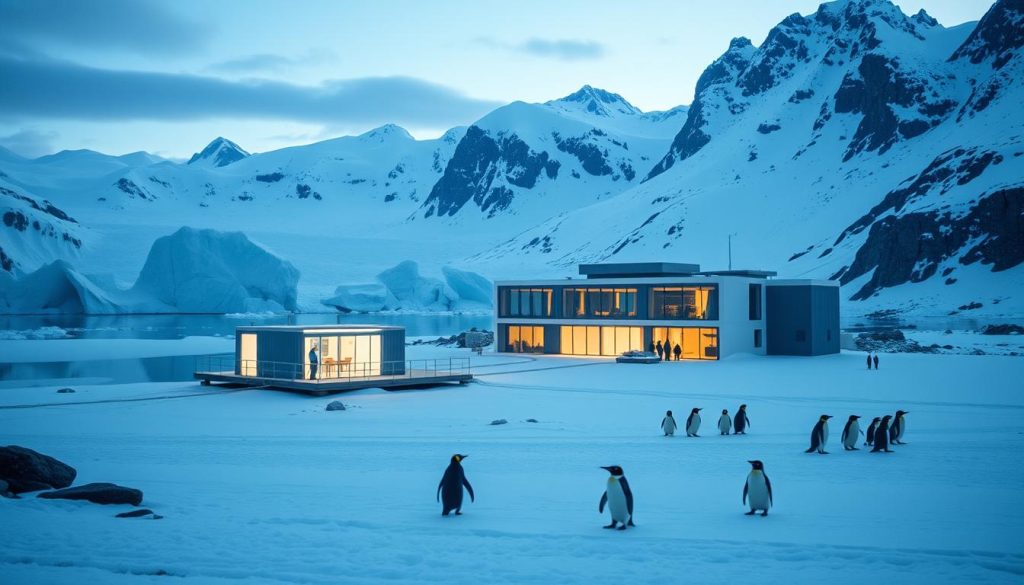
Antarctica is a land of opportunity across various sectors due to its unique environment. It calls for cooperative effort in science and managing resources. The impact of Antarctic explorations for science is huge, setting the stage for new findings and deeper planet insights.
Research and Scientific Expeditions
At Antarctica’s heart is scientific research. Teams from worldwide universities work together on projects to grasp climate change and biodiversity. Events like the International Polar Year stress the need for global collaboration in science. This field not only aids scientists but also fosters sustainable ventures.
Tourism Opportunities
Eco-tourism and adventure are booming in Antarctica, drawing in those keen for unique experiences. This industry is tightly controlled to protect the distinct environment and help the economy. Firms that prioritize eco-friendly tourism can make a real difference. They provide learning moments for visitors about the area’s delicate nature and value.
Mining and Resource Extraction
Though full of potential, Antarctic mining faces tough rules. It’s vital to weigh economic gains against environmental care. Looking at trends and new tech helps judge mining’s real chances, keeping eco-rules in mind. Knowing the effects of these factors is key for new companies.
Funding and Investment Strategies
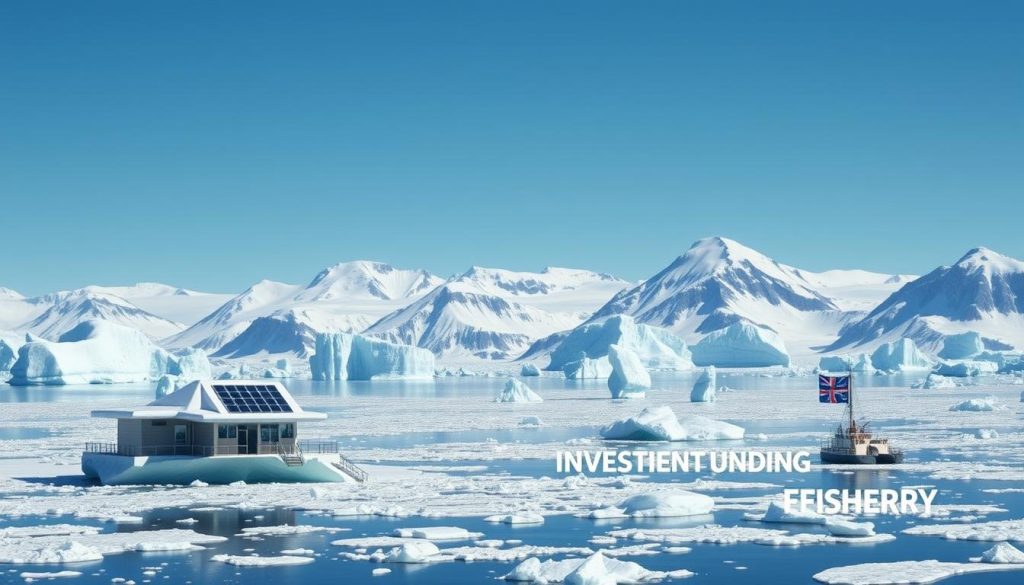
Getting enough funding is key for businesses working in Antarctica’s tough setting. Many options exist, including government grants that encourage research and eco-friendly practices. This section looks at these opportunities, what they focus on, and how to apply well.
Government Grants and Support
There are many government grants to help Antarctic businesses. These grants support innovation and help companies meet green rules. Businesses can look into these funding sources:
- Research and Development Grants
- Environmental Protection Funding
- Support for Sustainable Initiatives
Getting these grants means knowing the rules and making strong proposals that match the grants’ goals. A good proposal can greatly improve your chance of getting needed funds.
Private Investment Opportunities
It’s important to attract private investors interested in Antarctica’s unique market. Ways to draw in private funds include:
- Looking for investors who value sustainability.
- Partnering with groups with similar interests.
- Using tailored venture capital methods for Antarctica.
Making connections with investors who care about social responsibility can lead to new funding chances. This lets businesses grow in this challenging area.
Regulations and Legal Considerations
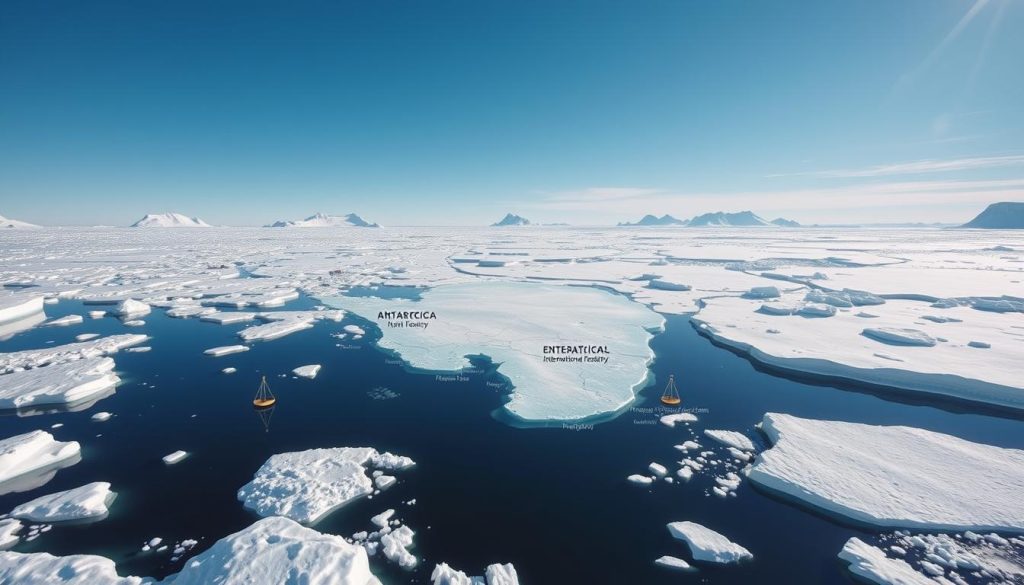
It’s vital to know the rules for doing business in Antarctica. The main laws come from international agreements and Antarctic treaties. Signed in 1959, the Antarctic Treaty is key. It encourages science work and protects Antarctica’s special nature. This treaty, along with other pacts, sets the rules businesses must follow.
International Treaties Governing Antarctica
If you’re planning to work in Antarctica, remember several international treaties are in place. Important ones are:
- Antarctic Treaty
- Protocol on Environmental Protection to the Antarctic Treaty
- Convention for the Conservation of Antarctic Marine Living Resources
These treaties help keep the region safe and support science and exploration. Following these rules is crucial. It shows you respect international law, especially important for big projects there.
Compliance and Permissions
For Antarctic ventures, getting the right permissions is key. You must know and follow all legal needs. Here’s what businesses should do:
- Find out which Antarctic treaties and international laws apply.
- Get advice from government and international groups.
- Apply for the permits you need to work in Antarctica.
Though getting permissions is tricky, it’s essential. It ensures your activities are legal. Being ready and keeping up with law changes helps you stay lawful.
Collaborations with Research Institutions
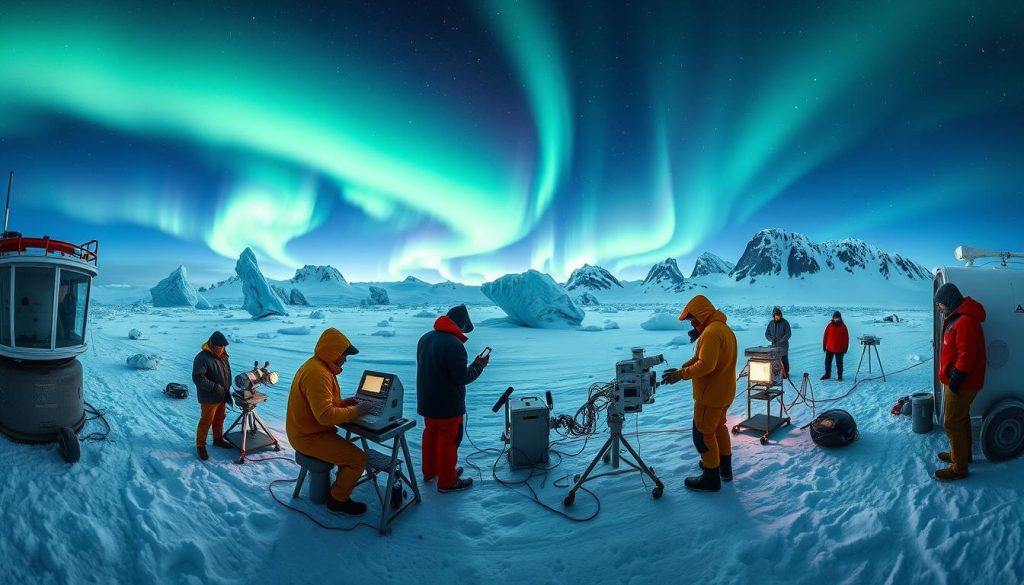
Businesses can grow in Antarctica by working with research institutions and universities. By doing so, they tap into advanced science and new solutions. These are specially made for Antarctica’s challenges. Working together boosts business operations and expands scientific knowledge.
Building Partnerships with Universities
Connecting with universities brings a wealth of innovation and shared knowledge. Such partnerships can be diverse, including:
- Joint research projects focusing on climate impact and wildlife studies.
- Internship programmes for students to gain practical experience in Antarctic conditions.
- Access to state-of-the-art facilities for experimental research and development.
Shared Resources and Infrastructure
Sharing resources and infrastructure helps cut down business costs. Businesses become more efficient and create strong networks by working together. Important parts of sharing include:
- Shared laboratory space to conduct scientific studies.
- Collaborative use of transportation and supply services to streamline logistics.
- Development of communal databases and tools for data sharing among partners.
Technological Innovations for Extreme Conditions
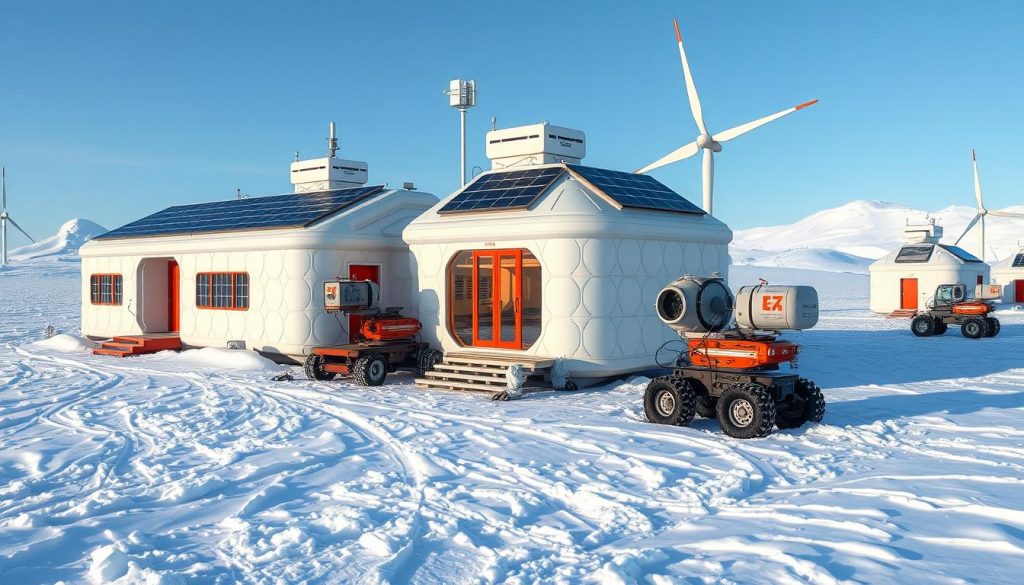
Cold-weather technology is key in improving Antarctic infrastructure. Businesses are overcoming extreme condition challenges with new engineering breakthroughs. These breakthroughs ensure both safety and efficiency by using advanced materials and methods.
Advancements in Cold-Weather Engineering
The progress in cold-weather engineering has been remarkable. Now, buildings can stand up to very low temperatures and tough environments. Focus areas include thermal insulation for better indoor climate, strong frameworks for heavy snow, and energy-saving systems to cut costs.
Remote Monitoring Technologies
Remote monitoring tech is revolutionizing data handling and analysis in Antarctica. It offers benefits like real-time data for quick decisions. Plus, it improves efficiency by constantly watching over resources and conditions. It also blends different data types for a full view of situations.
Human Resource Management in Antarctica
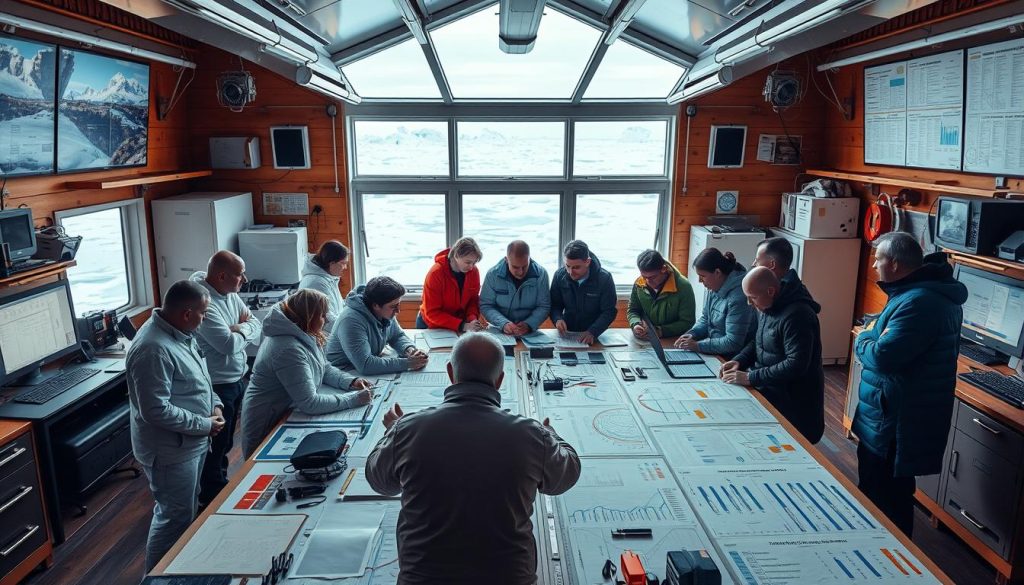
HR management is key for employee wellbeing and safety in Antarctica. It’s important to create a workplace where everyone feels supported. This helps everyone deal with the harsh conditions they face. Companies need strategies to keep morale and productivity high.
Employee Welfare and Safety Protocols
The health of staff affects how well operations run. Looking after employee welfare means supporting mental health and following strict safety rules. This is essential in the extreme conditions of Antarctica. Some best practices are:
- Regular health checks to keep an eye on both mental and physical health.
- Easy ways to report any safety worries.
- Enough emergency supplies and training for everyone.
Training for Extreme Conditions
Training for extreme conditions is crucial for success. Proper training and ongoing courses make staff ready and confident. Effective training includes:
- Real-life simulations to prepare for Antarctica’s challenges.
- Teaching survival and emergency response skills.
- Regular courses to ensure everyone’s skills are up to date.
Marketing and Outreach Strategies

In Antarctica’s competitive world, good marketing and outreach can really make a difference. Tailoring your approach helps reach the right people in such a unique place. We’ll look at the best ways to get your message across in this cold, vast space.
Targeting Niche Markets
Knowing what special groups of customers want is key in Antarctica. Here are some smart moves:
- Doing deep research to figure out who exactly your customers are.
- Making solutions that solve the special problems of living in Antarctica.
- Using online tools to talk directly to these people.
Branding in Extreme Environments
To stand out in Antarctica, you need a strong brand that tells your story. Use the area’s unique features to your advantage. Think about these ideas:
- Telling a story that shows how special the Antarctic experience is.
- Being green and caring for the environment as part of your brand.
- Building relationships with people who support what you do.
Case Studies of Successful Businesses in Antarctica

Antarctica is a tough place for business, but some have thrived. These cases show how being flexible and creative can lead to success in tough conditions. They prove that with the right approach, even the most challenging environments can be conquered.
Highlighting Innovative Initiatives
Some businesses in Antarctica really stand out. For example, eco-tourism companies use sustainable methods to protect the environment. Meanwhile, research companies have made new tech to work more efficiently. These examples show that clever ideas contribute to business success in far-off places.
Lessons Learned from Pioneering Ventures
Studying these businesses teaches valuable lessons to anyone thinking of starting up in Antarctica. It’s crucial to plan well and manage resources wisely. The strategies these trailblazers used show that innovation and working together can lead to triumph. Such approaches reduce risks and create opportunities for future projects in Antarctica.
The Future of Business in Antarctica
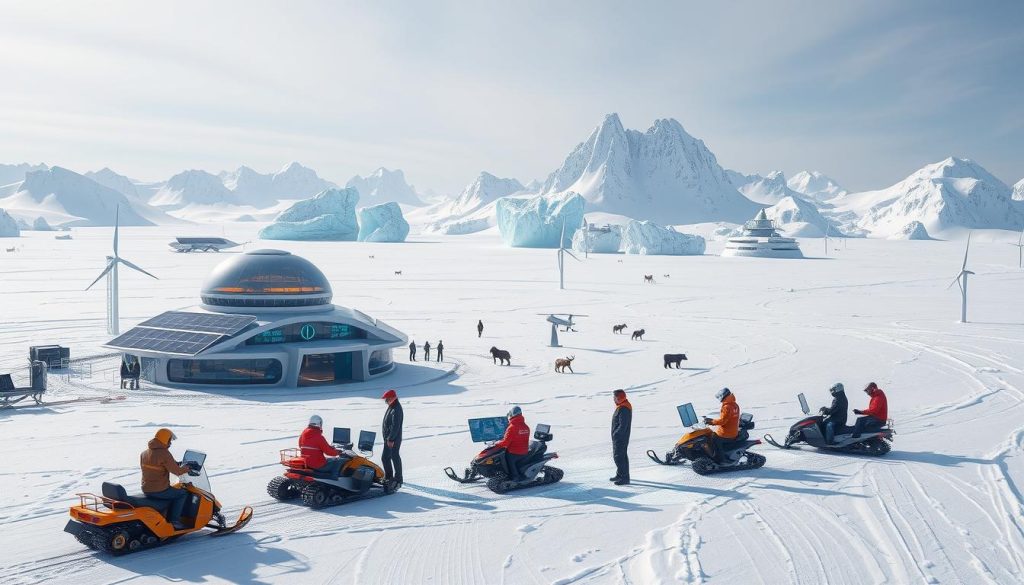
As global policy changes, businesses in Antarctica are focusing on sustainability and responsible actions. They must look at their impact on this unique continent with care. Working sustainably is vital for companies wanting to succeed in challenging conditions.
Long-Term Sustainability and Impact
For businesses to last in Antarctica, adopting sustainable methods is key. They should:
- Use eco-friendly tech to reduce environmental impact.
- Manage resources responsibly to keep in line with sustainability.
- Work with environmental groups to boost conservation.
Anticipating Changes in Global Policies
Understanding global policy changes is crucial for Antarctic firms. They may need to:
- Adjust their business plans to fit new rules.
- Connect with governments to grasp policy changes.
- Spend on research to predict and adapt to policy-induced environmental shifts.
Conclusion: Navigating the Future of Antarctic Business
As we wrap up our journey into Antarctic business future, we see innovation and resilience are crucial. Operating there means facing tough conditions and strict rules. Yet, this presents a chance for businesses willing to adapt. Embracing new technology and focusing on sustainability can set some companies apart in this unique market.
To succeed, businesses must overcome logistical obstacles and work closely with research bodies and the local community. This partnership approach is critical. It helps businesses run smoothly while respecting the rules that protect the Antarctic. Keeping up with new regulations is also key for anyone looking to venture into this harsh yet promising territory.
Success in Antarctica demands a forward-looking attitude. Learning from those who have already made it and staying ahead of policy changes is vital. Although the road ahead is tough, with careful planning and a strategic outlook, businesses can flourish in one of Earth’s most extreme locations.

